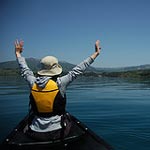Without a kayak, you are swimming. There are several kinds, but the sea and recreational kayaks are recommended for this area.
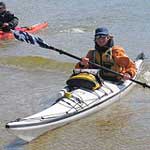 Sea/Touring - These kayaks are definitely an option for the central florida area. They are long and lean, and have plenty of storage space, which comes in handy if you plan to fish, camp or bring cameras. They are usually sit-ins, where the paddler is contained in the kayak from the waste down. They can be either single or double occupancy, and occasionally have rudders to help steer in open water (if you are kayaking in Gainesville and come across open water, you are in trouble). The advantages? They go a long way with each paddle (efficiency), they are very stable, they have ample storage and they look pretty darn nice slicing through the water. The downside? They are hard to maneuver and can be difficult to transport. If you are planning to use your 'yak in mangroves or canals, sea kayaks can be tricky. Want some specifics? Check out this example.
Sea/Touring - These kayaks are definitely an option for the central florida area. They are long and lean, and have plenty of storage space, which comes in handy if you plan to fish, camp or bring cameras. They are usually sit-ins, where the paddler is contained in the kayak from the waste down. They can be either single or double occupancy, and occasionally have rudders to help steer in open water (if you are kayaking in Gainesville and come across open water, you are in trouble). The advantages? They go a long way with each paddle (efficiency), they are very stable, they have ample storage and they look pretty darn nice slicing through the water. The downside? They are hard to maneuver and can be difficult to transport. If you are planning to use your 'yak in mangroves or canals, sea kayaks can be tricky. Want some specifics? Check out this example.
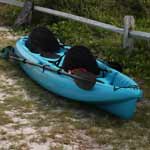 Recreational - Recreational kayaks have the reputation as a beginner's 'yak, and to an extent, it's well deserved. Recreationals are great for beginners. They are wide and stable, with either one or two seats. They are comfortable, often sit-ons, and are much easier to maneuver than a sea kayak. However, they are also good for more experienced kayakers. They are a good combination of speed and agility, like a star running back. They aren't for those who are looking to paddle for several miles through choppy seas, or for those looking to brave a raging river, but for the weekend adventurer, they are great. Like sea kayaks, they have lots of storage space, and they can be outfitted with fishing rod holders and in-kayak bait buckets. They are great on lakes, calm rivers, springs and in bayous on the coast. If you are looking to begin kayaking in the greater Gainesville area, you'd be hard pressed to find anything more versatile than a quality recreational kayak. Hobie makes some really nice recreational kayaks, and as with most of their 'yaks, they are fully customizable. Here's a good one.
Recreational - Recreational kayaks have the reputation as a beginner's 'yak, and to an extent, it's well deserved. Recreationals are great for beginners. They are wide and stable, with either one or two seats. They are comfortable, often sit-ons, and are much easier to maneuver than a sea kayak. However, they are also good for more experienced kayakers. They are a good combination of speed and agility, like a star running back. They aren't for those who are looking to paddle for several miles through choppy seas, or for those looking to brave a raging river, but for the weekend adventurer, they are great. Like sea kayaks, they have lots of storage space, and they can be outfitted with fishing rod holders and in-kayak bait buckets. They are great on lakes, calm rivers, springs and in bayous on the coast. If you are looking to begin kayaking in the greater Gainesville area, you'd be hard pressed to find anything more versatile than a quality recreational kayak. Hobie makes some really nice recreational kayaks, and as with most of their 'yaks, they are fully customizable. Here's a good one.
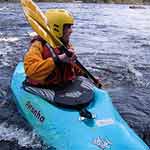 Whitewater - These suckers are wide, short and ultra-stable. They are durable and can handle being pounded against rocks. They rarely flip, and when they do, they are easy to right. They are easy to transport and are unbelievably maneuverable. If your apartment floods, you could kayak from the bathroom to the kitchen without issue. They are usually made out of highly durable materials, capable of smashing up against rocks without cracking or shattering. Some whitewater kayaks are designed for tricks - but that's a discussion for a different website entirely. The downside? If you want to get around in anything but a fast moving river, you have to paddle your arms off. We don't recommend these for this part of the country, but try them for yourselves and get an idea. If you insist (and have money to spend), take a look at this one.
Whitewater - These suckers are wide, short and ultra-stable. They are durable and can handle being pounded against rocks. They rarely flip, and when they do, they are easy to right. They are easy to transport and are unbelievably maneuverable. If your apartment floods, you could kayak from the bathroom to the kitchen without issue. They are usually made out of highly durable materials, capable of smashing up against rocks without cracking or shattering. Some whitewater kayaks are designed for tricks - but that's a discussion for a different website entirely. The downside? If you want to get around in anything but a fast moving river, you have to paddle your arms off. We don't recommend these for this part of the country, but try them for yourselves and get an idea. If you insist (and have money to spend), take a look at this one.
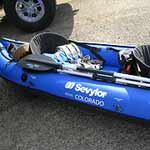 Inflatables - This isn't really a style of kayak, but it's worth discussing for a moment. Inflatables are popular, especially in urban areas where people don't have lots of storage space. They can be uninflated and kept in a trunk or a closet. They inflate quickly, usually with the help of a foot pump (don't worry, you won't have to blow them up beach-ball style). All but the cheapest ones have multiple air compartments. They are usually on the smaller side, and paddle similar to most recreational kayaks. However, they have one major problem - they pop. If you poke a hole in your inflatable, you are going for a swim. This presents additional problems. If you have anything on board, it's going down with the ship. Also, this is Florida, and if you are in a lake or river, you aren't the only big carnivore trolling the waters. If you're up for the risk, consider this one.
Inflatables - This isn't really a style of kayak, but it's worth discussing for a moment. Inflatables are popular, especially in urban areas where people don't have lots of storage space. They can be uninflated and kept in a trunk or a closet. They inflate quickly, usually with the help of a foot pump (don't worry, you won't have to blow them up beach-ball style). All but the cheapest ones have multiple air compartments. They are usually on the smaller side, and paddle similar to most recreational kayaks. However, they have one major problem - they pop. If you poke a hole in your inflatable, you are going for a swim. This presents additional problems. If you have anything on board, it's going down with the ship. Also, this is Florida, and if you are in a lake or river, you aren't the only big carnivore trolling the waters. If you're up for the risk, consider this one.




